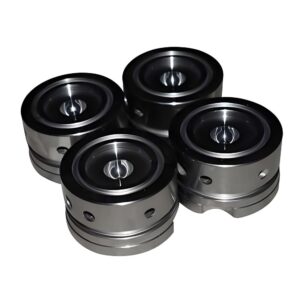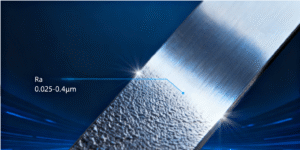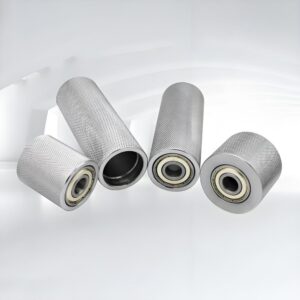321 Stainless Steel—ever heard of it? If you’re knee-deep in the manufacturing world, this remarkable alloy could be the solution you’ve been searching for. When high temperatures threaten to warp your components or corrosion starts eating away at your equipment, 321 Stainless Steel stands strong. Used in everything from the pipes of chemical plants to the structural beams of skyscrapers, it’s a material that engineers trust. Curious to find out why it’s become a go-to choice for tough manufacturing jobs? Let’s explore its incredible features together.
What Is 321 Stainless Steel?
321 stainless steel is an austenitic stainless steel alloy, a type of metal known for its corrosion resistance and strength. What sets 321 apart from other stainless steels, like the popular 304 grade, is the addition of titanium, which gives it enhanced stability at high temperatures. This makes it a favorite in industries where heat resistance is critical, such as aerospace, automotive, and chemical processing.
The alloy belongs to the 300-series of stainless steels, which are known for their non-magnetic properties and excellent formability. By understanding its composition and properties, you can better appreciate why 321 stainless steel is so widely used and how it can be machined for various applications.
Composition of 321 Stainless Steel
To understand what makes 321 stainless steel unique, let’s take a closer look at its chemical makeup. The alloy is primarily composed of iron, with other elements added to enhance its performance. Here’s a breakdown of its key components:
Key Elements in 321 Stainless Steel
- Iron (Fe): The base metal, making up the majority of the alloy.
- Chromium (Cr): Typically 17–19%, chromium provides corrosion resistance by forming a protective oxide layer on the surface.
- Nickel (Ni): Around 9–12%, nickel enhances corrosion resistance and improves the alloy’s strength and ductility.
- Titanium (Ti): Present in small amounts (about 0.7% or less), titanium stabilizes the alloy at high temperatures by preventing carbide precipitation.
- Carbon (C): Kept low (0.08% or less) to minimize the risk of corrosion.
- Manganese (Mn), Silicon (Si), and Others: These elements are added in smaller quantities to improve strength, formability, and other properties.
This carefully balanced composition gives 321 stainless steel its signature heat resistance and durability, making it ideal for demanding environments.
How Composition Affects Performance
The combination of chromium and nickel ensures excellent corrosion resistance, while titanium’s stabilizing effect allows 321 stainless steel to perform well in temperatures ranging from 800°F to 1650°F (427°C to 899°C). This makes it a reliable choice for applications where other alloys might fail due to heat or corrosion.
Properties of 321 Stainless Steel
The properties of 321 stainless steel make it a standout choice for many industries. Let’s explore the characteristics that define this alloy and why they matter.
Corrosion Resistance
Like other austenitic stainless steels, 321 offers excellent resistance to corrosion, particularly in environments exposed to moisture, chemicals, or salts. The chromium in the alloy forms a passive oxide layer that protects the material from rust and degradation. This makes 321 stainless steel suitable for use in harsh conditions, such as marine environments or chemical processing plants.
High-Temperature Strength
One of the standout features of 321 stainless steel is its ability to withstand high temperatures without losing strength or corroding. The titanium stabilization prevents the formation of harmful carbides, allowing the alloy to maintain its structural integrity in extreme heat. This makes it ideal for applications like exhaust systems, jet engine components, and industrial furnaces.
Formability and Weldability
321 stainless steel is highly formable, meaning it can be shaped into complex parts without cracking or losing strength. It’s also easy to weld, making it a favorite for manufacturers who need to join metal components. The alloy’s titanium content ensures that welds remain strong and corrosion-resistant, even in high-temperature environments.
Non-Magnetic Properties
As an austenitic stainless steel, 321 is non-magnetic in its annealed state, which is useful in applications where magnetic interference could be an issue, such as in electronic or medical equipment.
Mechanical Properties
- Tensile Strength: Approximately 75 ksi (515 MPa), making it strong enough for structural applications.
- Yield Strength: Around 30 ksi (205 MPa), indicating good resistance to deformation.
- Elongation: About 40%, showing excellent ductility for forming and bending.
These properties make 321 stainless steel a versatile material that balances strength, flexibility, and durability.
Applications of 321 Stainless Steel
Thanks to its unique combination of properties, 321 stainless steel is used in a wide range of industries. Below are some of the most common applications where this alloy shines.

Aerospace Industry
In aerospace, components like exhaust manifolds, turbine blades, and heat exchangers often operate at high temperatures. 321 stainless steel’s ability to resist oxidation and maintain strength in these conditions makes it a top choice for aircraft and spacecraft parts.
Automotive and Exhaust Systems
The automotive industry relies on 321 stainless steel for exhaust systems, where high temperatures and corrosive gases are common. The alloy’s heat resistance and corrosion resistance ensure long-lasting performance in these demanding environments.
Chemical Processing
Chemical plants often handle corrosive substances and operate at elevated temperatures. 321 stainless steel is used in equipment like reactors, piping, and storage tanks, where its resistance to corrosion and heat ensures reliability and safety.
Medical and Pharmaceutical Equipment
The alloy’s corrosion resistance and non-magnetic properties make it suitable for medical devices and pharmaceutical equipment, such as surgical tools and processing vessels. Its ability to be sterilized without degrading adds to its appeal in these industries.
Food and Beverage Industry
While not as common as 304 stainless steel in food processing, 321 stainless steel is sometimes used in equipment exposed to high temperatures, such as ovens or heat exchangers. Its corrosion resistance ensures hygiene and durability in these applications.
Other Applications
- Oil and Gas: Piping and fittings in refineries.
- Power Generation: Boiler components and heat exchangers.
- Construction: Structural components in high-temperature or corrosive environments.
The versatility of 321 stainless steel makes it a valuable material across these diverse fields, meeting the needs of both high-performance and everyday applications.
Common machining Processes for 321 Stainless Steel
Machining 321 stainless steel requires precision and expertise due to its strength and work-hardening tendencies. Below are some of the most common machining processes used to shape this alloy.

CNC Machining
Computer Numerical Control (CNC) machining is widely used for 321 stainless steel. This process allows for precise cutting, drilling, and milling to create complex parts with tight tolerances. CNC machines are ideal for producing aerospace components, automotive parts, and other high-precision items.
Tips for CNC Machining 321 Stainless Steel
- Use Sharp Tools: Dull tools can cause work hardening, making the material tougher to cut.
- Low Cutting Speeds: Slower speeds reduce heat buildup and prevent tool wear.
- Coolants: Proper cooling is essential to manage heat and extend tool life.
Welding
321 stainless steel is highly weldable, thanks to its titanium content, which prevents weld decay (loss of corrosion resistance at weld points). Common welding methods include:
- TIG Welding (Tungsten Inert Gas): Preferred for its precision and clean welds.
- MIG Welding (Metal Inert Gas): Suitable for thicker sections and faster production.
- Shielded Metal Arc Welding (SMAW): Used for fieldwork or repairs.
Proper welding techniques ensure strong, corrosion-resistant joints that maintain the alloy’s properties.
Forming and Bending
The alloy’s excellent formability allows it to be bent, rolled, or stamped into various shapes. This is particularly useful for creating pipes, tubes, or structural components. However, care must be taken to avoid overworking the material, as it can harden during forming.
Heat Treatment
321 stainless steel is typically supplied in the annealed condition, which softens it for easier machining. Post-machining heat treatment, such as stress-relieving, may be used to reduce internal stresses without compromising the alloy’s properties. However, it cannot be hardened by heat treatment, as it is an austenitic stainless steel.
Surface Finishing
To enhance its appearance or corrosion resistance, 321 stainless steel can undergo surface finishing processes like polishing, brushing, or passivation. Passivation removes surface contaminants, further improving corrosion resistance.
Limitations of 321 Stainless Steel
While 321 stainless steel is a remarkable material, it’s not without its limitations. Understanding these can help users make informed decisions about when and how to use it.
Cost
Compared to other stainless steels, like 304, 321 is more expensive due to the addition of titanium and its specialized applications. For projects where high-temperature resistance isn’t needed, a cheaper alternative might be more cost-effective.
Work Hardening
321 stainless steel has a tendency to work-harden during machining or forming. This means the material becomes harder and tougher as it’s worked, which can lead to tool wear or difficulty in achieving precise cuts. Proper machining techniques, like using sharp tools and low cutting speeds, are essential to manage this issue.
Limited Availability
While not as rare as some exotic alloys, 321 stainless steel may not be as readily available as 304 or 316 stainless steel. This can lead to longer lead times or higher costs for sourcing the material.
Not Ideal for Extreme Corrosion
While 321 offers excellent corrosion resistance, it’s not the best choice for highly acidic or chloride-rich environments, where 316 stainless steel might perform better due to its molybdenum content. For marine or highly corrosive applications, other alloys may be more suitable.
Weld Imperfections
Although 321 is designed to resist weld decay, improper welding techniques can still cause issues, such as sensitization (loss of corrosion resistance) in extreme cases. Skilled welders and proper equipment are necessary to avoid these problems.
Why Choose 321 Stainless Steel?
Despite its limitations, 321 stainless steel is a top choice for applications requiring heat resistance, corrosion resistance, and formability. Its ability to perform in high-temperature environments makes it indispensable in industries like aerospace, automotive, and chemical processing. By understanding its composition, properties, and machining requirements, manufacturers can unlock the full potential of this versatile alloy.
For those looking to work with 321 stainless steel, partnering with an experienced machining company is key. Precionn, a leader in the precision machining industry, specializes in crafting high-quality components from materials like 321 stainless steel. With a focus on advanced CNC machining and a commitment to quality, Precionn delivers tailored solutions for aerospace, automotive, and other demanding applications. Visit their website to learn more about how they can bring your project to life with precision and expertise.



